Introduction to the used tyres recycling
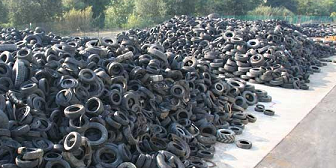
As it has known, the industrialization and the development have changed the environmental conditions of the Earth, producing besides wealth, even a wide and often uncontrollable mass of rubbish. The protection of the environment is by now, an issue that one cannot renounce in the civil and industrial society of the third millennium and the law, that aims to guarantee it, is more and more wide and binding. Among them, the used tyre is one of the serious problems to solve because it is a material difficult to treat. In particular, for its elastomeric characteristics it is hard to recover, if the suitable working processes are not adopted. In the European Union the used tyres annual build-up is of about 3.250.000 tons of pieces. In Italy every year about 400.000 tons of tyres are thrown away, 50% of them is intended to a recycling process. There is so, the need of advanced structures which can dispose, divided and recycling these materials respecting the environment. Thanks to the experience made from our team since the beginning of the 90’s, we managed to realize a “perfect plant”, where security, management and quality are the best characteristics known world-wide. We were born and defined as “Pioneer” of the tyre recycling, our plant is composed of different apparatus made to specifications for the type of processing to do. The machines are conceived for a specific purpose, using special non-abrasive materials, which give long life to the mechanical components of the processing. This means that to place one’s trust in real expert, it is a winning key in the tyre recycling. The tyre today on the market is composed principally of three different components: elastomeric rubber, harmonic steel, textile fibre. The percentages of these components changes according to the type and the model of tyre and according to its application on road. Generally, these products distinctions have the following compositions on percentage:
| Components/Type of tyre | Car tyre | Road transport truck tyre | Earthworks truck tyre | Agricultural tyre | Earthworks tyre (Texil) | Earthworks tyre (Steel) |
| Elastomer | SBR 70% | SBR 70% | SBR 75% | 70% | 70% | 70% |
| Steel | 15% | 28% | 20% | 15% | 15% | 30% |
| Textile fibre | 15% | 0 | 5% | 15% | 15% | 0 |
Recovery destination in Europe: 27 UE States
The obtained used tyres annual destination in the European territory represents about 3.250.000 tons for 27 country of the European Union, divided as the following pie chart.
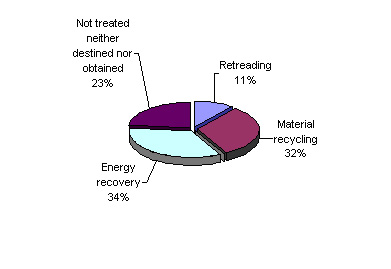
This pie chart allows to make a further large-scale assessment about the possibilities in the European Union to install new used tyres recovering plants.
23.2% of the material (about 747.500 tons) is even today cramed in provisional or illegal storages.
The pie chart of Italy about the present situation shows that like country we are even halfway of the work done in the European area and so we need to act soon enough in making an end of the serious environmental risks.
Trend 27 UE States
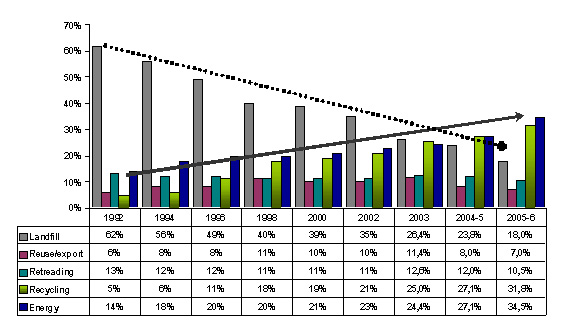
TIRES S.p.A. 100% ecological recycling process
The activity of TIRES SPA is to build, supply and start up used tyres recycling plants, which produce rubber granulates and powder. TIRES SPA plants are projected in such a manner that all parts subjected to wear are easily interchangeable. The recycling process provided by TIRES SPA is principally constituted of the following phases:
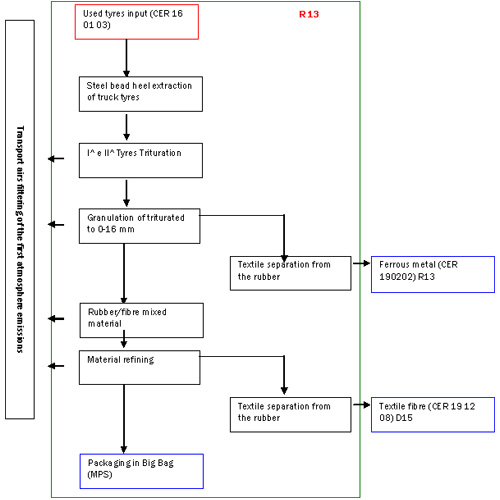
Approximate characteristics of the productive settlement
| Necessary surface for the realization of the plant according to the productive capacities | |
| Plant of 8.900 ton/year | mq. 7.000 |
| Building | mq. 1.600 |
| Square | mq. 5.000 |
| Warehouse | mq. 400 |
| Plant of 17.500 ton/year | mq. 13.000 |
| Building | mq. 2.400 |
| Square | mq. 10.000 |
| Warehouse | mq. 600 |
These characteristics are the basis for the rubber granules and powders production. The request to obtain an higher productivity consists on doubling the used tyres working forms doubling at least the building size.
Operative data
On charge the tyre entry is usually composed as following:
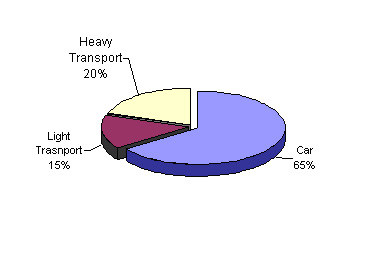
This is a valuation of the used tyre availability according to the cars density for a line of 17.500 ton/year:
| Car | 1.418.918 pz | 354.729 means |
| Light transport | 130.977 pz | 32.744 means |
| Heavy transport | 58.212 pz | 7.277 means |
A grinding/granulation/refining line can recycle and reduce used tyre in different sizes according to the following productive characteristics:
| granules 0.8-3 mm | 5.300 ton/year |
| rubber powder 0/800 micron | 388 ton/year |
| steel coming from steel bead heel extraction | 315 ton/year |
| steel wires | 1.867 ton/year |
| powders and textile fibres | 1.030 ton/year |
| Totals | 8.900 ton/year |
or
| granules 2.5-4 mm | 5.675 ton/year |
| granules 0.8/2.5 mm | 5.457 ton/year |
| rubber powder 0/800 micron | 364 ton/year |
| steel coming from steel bead heel extraction | 315 ton/year |
| steel wires | 1.867 ton/year |
| powders and textile fibres | 1.600 ton/year |
| Totals | 17.500 ton/year |
Every pulverization form takes away the productive capacity of a refining form decreasing further the granulometry under 400 micron:
| granules 800/2000 micron | 485 ton/year |
| rubber powder 400/800 micron | 727 ton/year |
| rubber powder 0-400 micron | 1.455 ton/year |
| Totals | 2.667 ton/year |
Tyre composition
- CAR TYRE
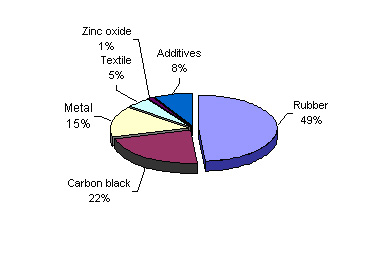
- TRUCK TYRE
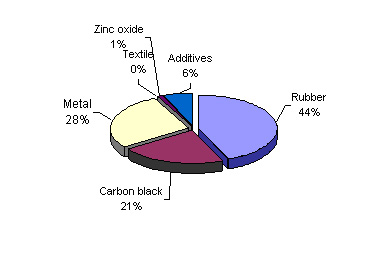
The most common rubber used in the production of passenger car tyres is styrene-butadiene co-polymer (SBR), which contains about 25% by weight of styrene in combination with SBR, other elastomers eg., natural rubber (cispolyisoprene), synthetic cispolyisoprene, and cispolybutadiene are used in varied amounts. A number of factors effect tyre selection, use and care including the local geographic conditions, variations in weather, the legal speed limits, as well as road structure and surfacing.
Recycled material application fields
Today the solutions for the rubber granules and powder use are lot and they are directly ruled by the Ministry of Environment. Below, we give indications for that use, which at the moment are in force in the Italian Official Gazette:
Definition of recycled material
Material realized using rubbish comes from the recovery activity of several rubber articles, in the weight limits forced from the technologies employed for the production of the same material. Recycled rubber materials admitted to the inscription in the recycling index. It is to insert, like an example and in a not exhausting way, in the list of the recycled materials, inside the recycling index:
- 1) Homogeneous elastomeric polymers composed of : SBR, NR, BR, IR, CR, CIIR, CSM, EPDM, rubber of silicon, rubber of fluoride, etc..
- 2) Heterogeneous vulcanized elastomeric polymers composed of: heterogeneous materials formed from different polymer matrixes.
- 3) Composite materials elastomeric and thermoplastic polymers-based (rubber and plastic mixtures).
- 4) Modified bitumen with rubber powder (wet technique).
- 5) Bituminous mix with rubber granule (dry technique).
- 6) Mixes of cement modified with rubber granule.
- 7) Mortars and premixeds with rubber powder and granule.
- 8) Premixeds of rubber powder and/or granule with other polymers and/or inerts.
- 9) Gummy mixes of resin of granule and/or powder and polyurethan, polymeric binders and/or other binders.
In these materials, from the point 1 to 9, the polymeric/elastomeric component (rubbish comes from consume) can be present in the form of powder, granules, chips, grinded, mixtures, scratching, etc. Utilization fields of the recycled materials. Building, urban furnishing, road and tram infrastructure, sport complexes, equipment and structures for playing, floors for indoors and outdoors, materials for gardening like rubber mulch, products for building, harbour infrastructure, several industrial products, products for agriculture, products for works of civil engineering.